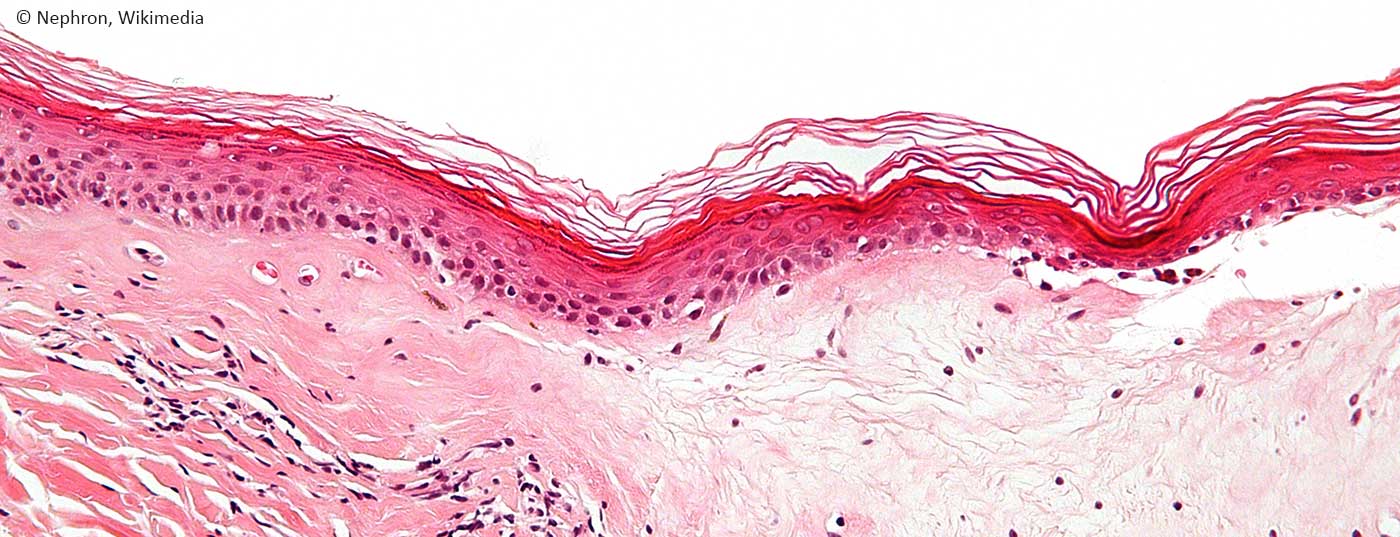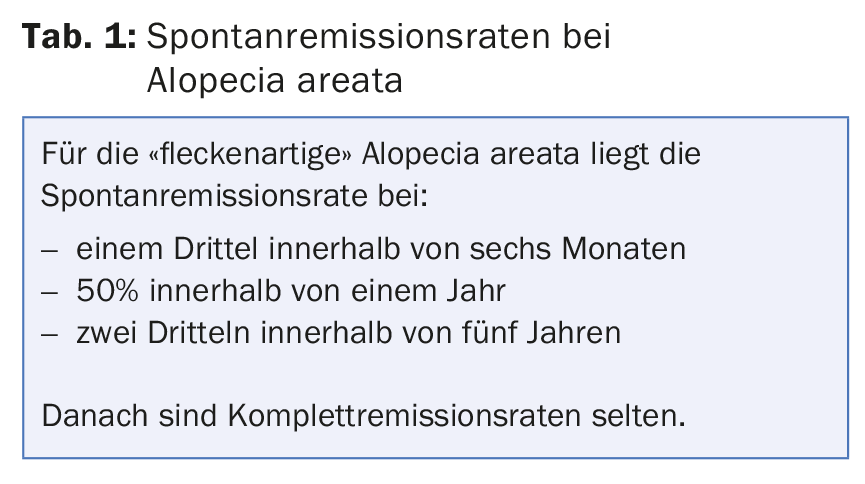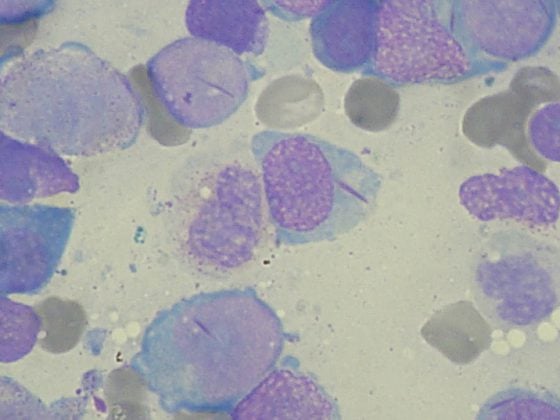As every year, the Swiss Derma Day covered a broad spectrum of lectures in dermatology and venereology. We would like to introduce two presentations in more detail. On the one hand, it was about hair loss, more precisely alopecia areata , which represents a challenge therapeutically, but also an opportunity. Secondly, lichen sclerosus et atrophicus was treated, which is a rare but important diagnosis especially in childhood.
“In our society, hair stands for power, control and strength; hair loss is therefore often accompanied by a deep sense of loss of control and helplessness, and its impact on the well-being of those affected should by no means be underestimated,” said Prof. Ralph M. Trüeb, MD, Wallisellen, introducing the audience to the topic. Thus, the conclusion of evidence-based medicine regarding alopecia areata may be misleading when a Cochrane Review from 2008 [1] states that in view of the possibility of spontaneous remission, especially for early phases, no therapy at all may be necessary or the wearing of a wig may be sufficient. “After all, the individual clinical expertise of the treating physicians and their own good experience – if they have any – should not be devalued by evidence-based medicine, but rather united with it and supplemented. In many cases, therapy makes sense and is successful,” said the speaker.
With regard to treatment, one should also always keep in mind that there may be numerous causes that interact to cause hair loss. Therefore, an open attitude towards the use of combined treatments and multi-target approaches is needed.
What is it about?
Alopecia areata is a T-cell mediated autoimmune disease of the hair follicles, which occurs frequently and in very different forms. It is characterized by acute onset and non-scarring hair loss in usually sharply defined areas. Some patients lose hair only in a small area, others suffer from a more pronounced or (more rarely) diffuse form. The course of alopecia areata is unpredictable in the individual patient. “So don’t commit yourself,” is the tip from the expert. However, large areal extent, long disease duration, and associated nail abnormalities have been associated with poorer prognosis. Spontaneous remission rates for alopecia areata are listed in Table 1. “Rates are high, but not high enough to generally not treat,” concludes. In addition, relapse occurs in 80% of cases within five years, and in 100% after 20 years. In adults with alopecia totalis or universalis with disease duration of at least five years, total remission rates are less than 10%.
How to proceed?
Any treatment for alopecia areata, in light of the above, should meet or measure up to the following criteria:
- of efficacy in the half-side test for alopecia totalis or universalis
- a higher remission rate compared to the spontaneous course
- a good safety profile with minimal toxicity.
From this, an empirical therapy algorithm can be derived depending on age, affected area and disease duration (with remission rates of 20-90% depending on the above factors). It is shown in Figure 1.
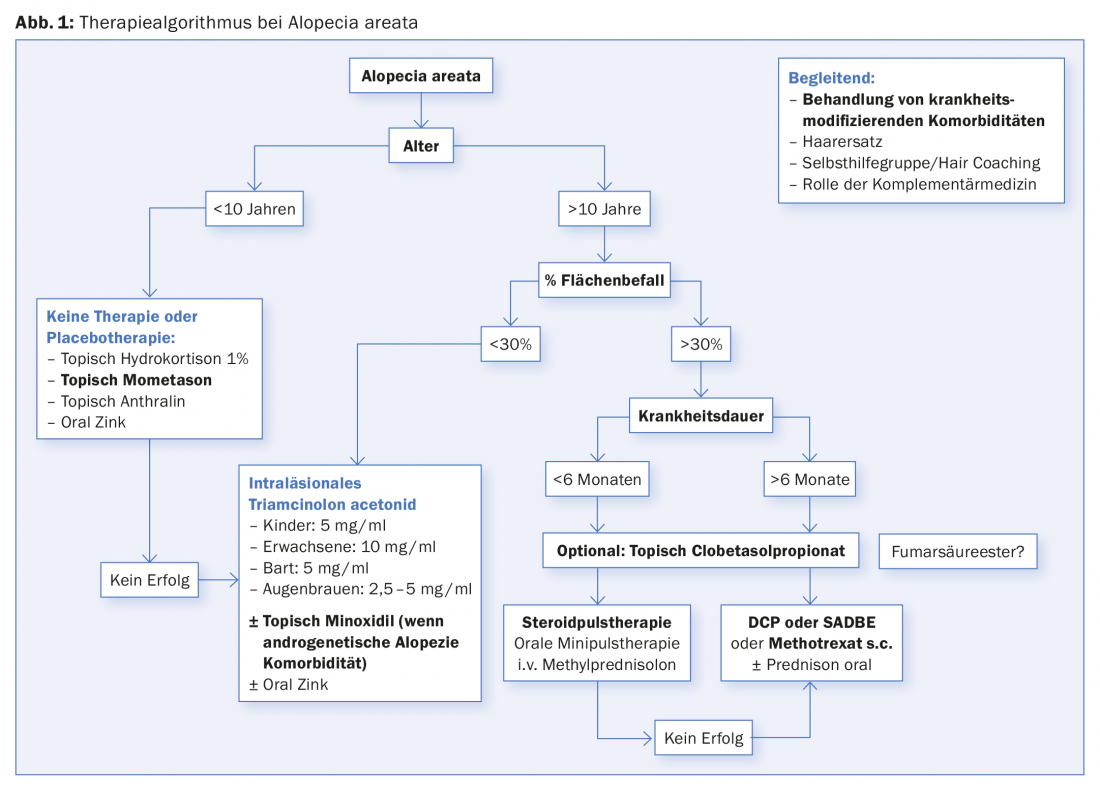
Comorbidities
“Since alopecia areata is itself an autoimmune disease, it is not surprising that associations with other autoimmune diseases exist,” Prof. Trüeb noted. Associations with lupus erythematosus, autoimmune thyroid diseases, pernicious anemia or celiac disease have been known for a long time. In addition, comorbidities were identified that may have a disease-modifying effect and thus need to be integrated into the treatment plan. These include:
- Iron deficiency [2]
- Vitamin D3 deficiency [3] (“One of my favorites: My feeling is that the results are even better with appropriate co-treatment,” the speaker said).
- androgenetic alopecia
- emotional stress
“However, the complexity of the pathogenesis should not only scare us, but also give us hope: Because it also means that there are many points of attack and thus many possibilities for targeted therapy,” Prof. Trüeb summarized.
One of these approaches, an interesting if expensive one, is inhibition of Janus kinase with JAK inhibitors such as tofacitinib or ruxolitinib.
Lichen sclerosus et atrophicus – State of research
” Lichen sclerosus et atrophicus is primarily an autoimmune-mediated disease in genetically predisposed individuals,” Prof. Peter Itin, MD, Basel, introduced his presentation on genital lichen sclerosus. Thus, autoimmunity (about 22% have autoimmune comorbidity, 42% autoimmune antibodies), genetic factors (about 12-21% positive family history, HLA cluster), trauma or irritation (coebnerization), infections (Lyme disease is discussed, also Epstein-Barr virus infections) and hormones (androgen deficiency) play a role in the pathogenesis. “Whereas Borrelia in particular continues to be controversial,” the speaker said.
There is an important association with morphea: affected individuals are significantly more likely to have genital lichen sclerosus than unaffected individuals. 45% of patients with plaque morphea have associated lichen sclerosus [4].
For the genital Lichen sclerosus in childhood, two further studies are of importance: a possibly important pathogenetic track is on the one hand the finding that antibodies against BP180 were found in one third of the girls examined [5], on the other hand that 79% of the cases of lichen sclerosus in childhood showed a reduction in ERRα (estrogen-related receptor) [6]. ERR regulate energy metabolism as well as cell cycle and inflammatory processes in normal, but also in cancer cells. Consequently, the study concludes that ERRα may play a role in the pathogenesis of both lichen sclerosus and vulvar squamous cell carcinoma.
Significant associations are also found with hypertension and hyperthyroidism, as well as a BMI of at least 25 kg/m2 – possible risk factors for genital lichen sclerosus [7].
Appearance of the disease
Disease signs and symptoms that present with lichen sclerosus are: Itching, pain, urinary restrictions or dysuria, dyspareunia, or significant sexual dysfunction. Often the perianal region is also affected. Blockages, bleeding and fissures can be found. “Childhood lichen sclerosus is a rare but important diagnosis – and also a challenge for us physicians,” noted Prof. Itin. “The diagnosis is delayed by years, despite a severe reduction in quality of life, which is certainly also related to certain inhibitions, but above all to insufficient education and information. So there is a need for action.” Table 2 summarizes the main subjective and objective symptoms in this group of patients. Another important feature is phimosis. Urethral involvement starts at the meatus. It turns out that one in five boys who underwent circumcision for lichen sclerosus subsequently needs another operation for meatal pathology. High-potency local steroids before circumcision may help reduce the rate of subsequent meatal problems [8]. “Synechiae should not be forgotten either,” the speaker reminded. “Finally, as mentioned, the associations with morphea, but also with atopy, should be noted.”
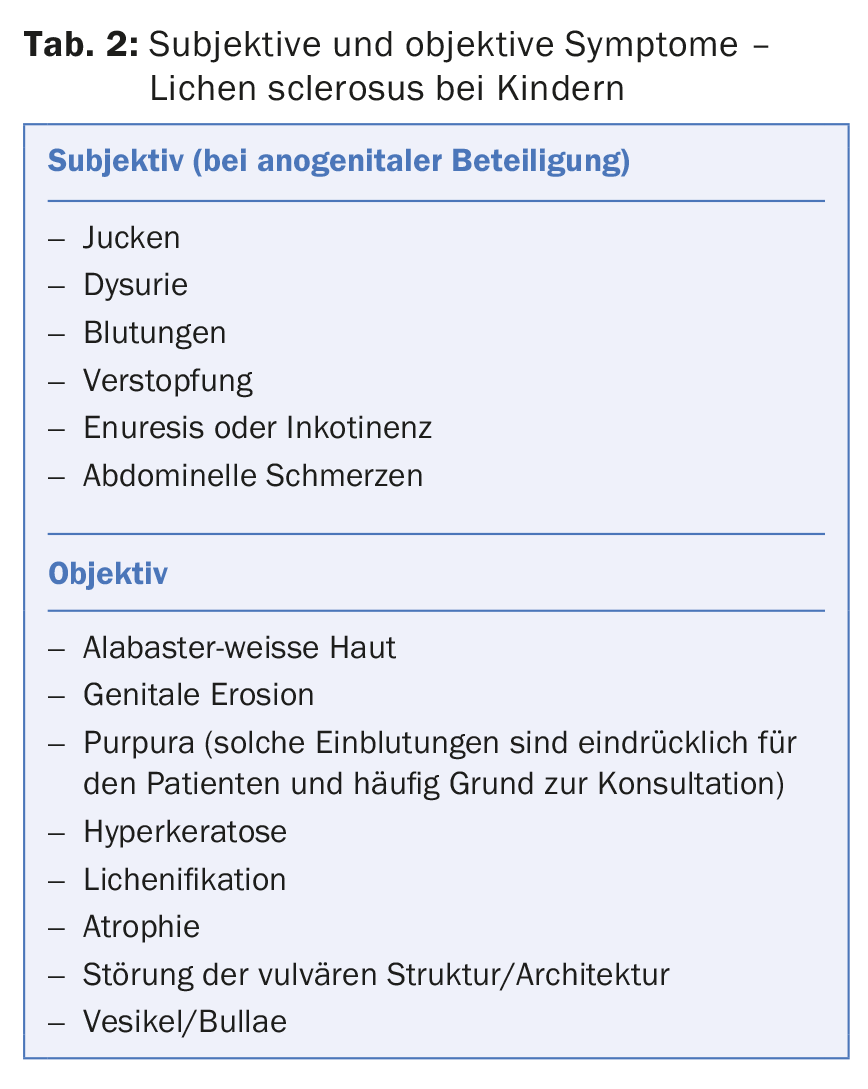
Treatment pathways
Biopsy should be considered if malignancy is suspected or even if recommended first-line therapy fails with adequate duration. Squamous cell carcinoma is a possible complication of lichen sclerosus et atrophicus.

Treatment is with potent and ultrapotent local steroids. “You can’t be afraid of that in this case,” Prof. Itin recommended. Other options include topical calcineurin inhibitors (“both pimecrolimus [9] and tacrolimus [10] work in childhood for anogenital lichen sclerosus”), topical and systemic retinoids, phototherapy for extragenital lichen sclerosus , photodynamic therapy for genital lichen sclerosus, and surgery (limited to scarring processes).
“By the way, vulvar lichen sclerosus does not heal during puberty, as was often claimed in the past. Therefore, a longer-term therapy is necessary. Side effects of long-term preventive topical corticosteroid administration are low, according to a large prospective study from 2015. Crucial, as always, is adherence [11].”
Source: Swiss Derma Day, January 11-12, 2017, Lucerne
Literature:
- Delamere FM, et al: Interventions for alopecia areata. Cochrane Database Syst Rev 2008 Apr 16; (2): CD004413.
- Kantor J, et al: Decreased serum ferritin is associated with alopecia in women. J Invest Dermatol 2003 Nov; 121(5): 985-988.
- Aksu Cerman A, Sarikaya Solak S, Kivanc Altunay I: Vitamin D deficiency in alopecia areata. Br J Dermatol 2014 Jun; 170(6): 1299-1304.
- Lutz V, et al: High frequency of genital lichen sclerosus in a prospective series of 76 patients with morphea: toward a better understanding of the spectrum of morphea. Arch Dermatol 2012 Jan; 148(1): 24-28.
- Baldo M, et al: Childhood vulval lichen sclerosus: autoimmunity to the basement membrane zone protein BP180 and its relationship to autoimmunity. Clin Exp Dermatol 2010 Jul; 35(5): 543-545.
- Lagerstedt M, et al: Reduction in ERRα is associated with lichen sclerosus and vulvar squamous cell carcinoma. Gynecol Oncol 2015 Dec; 139(3): 536-540.
- Virgili A, et al: New insights into potential risk factors and associations in genital lichen sclerosus: Data from a multicentre Italian study on 729 consecutive cases. J Eur Acad Dermatol Venereol 2016 Aug 12. DOI: 10.1111/jdv.13867 [Epub ahead of print].
- Homer L, et al: Meatal stenosis in boys following circumcision for lichen sclerosus (balanitis xerotica obliterans). J Urol 2014 Dec; 192(6): 1784-1788.
- Boms S, et al: Pimecrolimus 1% cream for anogenital lichen sclerosus in childhood. BMC Dermatol 2004 Oct 14; 4(1): 14.
- Li Y, et al: Low-concentration topical tacrolimus for the treatment of anogenital lichen sclerosus in childhood: maintenance treatment to reduce recurrence. J Pediatr Adolesc Gynecol 2013 Aug; 26(4): 239-242.
- Lee A, Bradford J, Fischer G: Long-term management of adult vulvar lichen sclerosus: A prospective cohort study of 507 women. JAMA Dermatol 2015 Oct; 151(10): 1061-1067.
DERMATOLOGIE PRAXIS 2017; 27(1): 36-39

